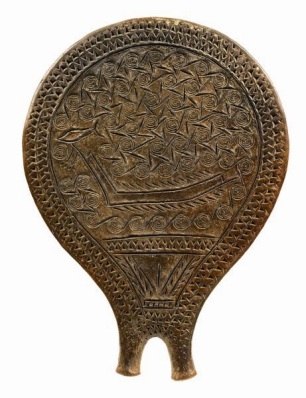Clay frying-pan vessel with incised decoration of a ship. Found at Chalandriani on Syros island. Early cycladic II period (Keros-Syros culture, 2800-2300 BC)
The Cyclades, because of their central location to trade in the eastern Mediterranean, have a rich and long history. They are a part of the vast number of islands that constitute the Greek archipelago in the Aegean Sea. The name was originally used to indicate islands that formed a rough circle around the sacred island of Delos.
The Cyclades are comprised of around 220 islands, with the major ones being Amorgos, Anafi, Ándros, Antiparos, Delos, Ios, Kéa, Kimolos, Kynthos, Mílos, Mykonos, Náxos, Páros, Pholegandros, Serifos, Sifnos, Sikinos, Síros, Tínos, and Santorini (Thíra). While ancient maritime trade made the region important strategically and geographically, a reliable agricultural base made life on the Cyclades archipelago possible. The Cyclades may have been one of the earliest sites of the worship of the Mother Goddess cult, which became widespread throughout the eastern and western Mediterranean.
All Mediterranean and Middle Eastern cultures including ancient Mesopotamia, Egypt, and later on, Greece, would feature prominent goddesses. When the Minoan culture flourished in the islands from about 3000 to 1450 b.c.e., frescoes on the walls of the palace, excavated by the British archaeologist Arthur Evans, featured a bare-breasted goddess with snakes. Snakes figured in many of the Mother Goddess cults in antiquity and had its parallel in the story of Eve and the serpent in the Garden of Eden in the Old Testament. Settlement of the Cyclades was sporadic. The Phoenicians were most likely the first settlers, while around 1000 b.c.e. the island was inhabited by the Ionians. In the case of Síros, ancient ruins, statuettes, and skeletons indicate the island had been settled by the Bronze Age.
The very dispersion of the islands made seafaring a necessary part of survival, as islanders learned that they could gain by trading with—or raiding—other islands in the archipelago. It is in these early boats that one can find the beginnings of the oared galleys that would be a feature of Mediterranean warfare until the 18th century at least, when the Knights of Malta used huge galleys in their wars against the Barbary pirates. Cycladic ships were the prototypes with which ancient Greece would plant its colonies, beginning around the sixth century b.c.e., and with which Rome would become the mistress of the Mediterranean.
The Cycladic culture peaked during the Minoan period, which was brought to life by the work of Arthur Evans with his reconstruction of the royal palace at Knossos. The story of European civilization begins on the island of Crete with a civilization that probably thought of itself as Asian (in fact, Crete is closer to Asia than it is to Europe). Thus, the Cyclades and Cretan Minoan civilization provided the first known fusion of Western and Asiatic culture. With the rise of Alexander the Great around 320 b.c.e., this would become the great Hellenistic civilization, which Alexander’s armies would carry to the very frontiers of India.
Further reading: Bent, J. Theodore, ed. The Cyclades, or Life among the Insular Greeks. Oxford: Archaeopress, 2002; “Tinos.” Available online. URL: http://www.tinos.com.gr (November 2005); Warry, John. Warfare in the Classical World. Norman: University of Oklahoma Press, 2002.
